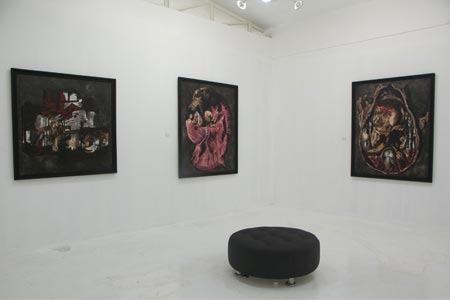Serving as a narrative offshoot of his first solo show, Hamilton Sulit’s latest paintings assemble a structure of memories that the viewer is invited to visit as one would a strange residence. In Haunted, Sulit continues to collage images within shaped canvases, which he then lays out in a figurative house interior. As in his first show, these images refer to memories that the artist considers as “tragic encounters,” mainly relational issues that had caused his estrangement both from the family he was born into and the family that he wished to build. Thus, in the four-walled gallery room, the viewer is made to walk through a “house” inhabited by battered chairs, film negatives, and other ghosts.
In Haunted, Sulit takes on the role of narrator and protagonist in what is essentially a story without a plot; that is to say, the story has no telos or end goal that the narrator or viewer finds in hindsight. Rather, the memories—little stories in themselves–happen as they are experienced or perceived. The story lies in the viewer’s visit. Sulit arranges the memories in a specific space, a metaphorical house, as, in a broader context, communities do with pilgrimage sites and commemorative museums. “If memory is about encounters,” Marta Zarzycka writes, “visual arts are the space of that encounter.” Haunted is such a space for remembering, which is also re-encountering. What is remembered is pain, and this remembered pain takes the form of the artifact. As Zarzycka describes it, “Memory is … both a finished piece of work and an act of looking.” Sulit’s meticulously shaped canvases are the result of the artist’s decision to engage in the physical, laborious process of painting, which is tempting to read as his attempt at catharsis.
Haunted opens with Back To The Old House, the old house being inhabited by spectral figures of two soldiers, aged faces, virginal women in the throes of ecstasy, crows and roses, and others. Its roof is on fire. The viewer assumes the point of view of the two children painted in the foreground, their backs to the viewer, their gaze at the direction of the house. As in reading a novel, from this point on the viewer goes along with the children, one of whom represents the narrator-protagonist. If the children enter the house despite the flames and phantoms, the viewer must enter it as well. How else to know what war the soldiers were in, or where the roses get their sustenance, or what the crows wait for?
As the viewer steps inside the haunted “walls,” he or she is drawn into the artist-storyteller’s tale of emotional pain. Tragic Encounter 1 refers to the artist’s physical and psychological alienation from his brother as they both at a very young age had to deal with the separation of their parents. Each boy figure contains images that pertain to two disparate narratives on the separation, which each brother has held on to on his own. Tragic Encounter 2 and 3 talk of the artist’s estrangement from his son and his son’s mother, with Tragic Encounter 2 focusing on the process of conception, the parents’ (failed) hopes and dreams being transferred to the fetus in the womb. Tragic Encounter 4 is a current portrait of the artist, the giant flower on his belly looking like guts being pecked by a vulture.
Battleground provides more images that could help place the other works in context: images of love and happiness remind the viewer that there is no pain without pleasure, and vice versa. Still features images of the artist’s friends as well as images of their shared experiences. Contained in the shape of a Polaroid camera, it represents Sulit’s process not only of recording memories, but of recreating them: memory, after all, relies heavily on visualization, on imaging, on imagining.
Joan Gibbons writes of how “The way that memory is valued … has shifted enormously from the idea of it being a storehouse of data which, given the right techniques, is recoverable in an ordered manner to the notion that it is a key to our emotional understanding of ourselves and the world.” The artist has ordered his memories precisely so that they could be recoverable. Recovered, they could be re-ordered, with the passage of time. Therein lies hope.
The tour of the old house ends in Walking Through Darkness, where the viewer is left with the choice of treading into the murky, uncharted forest beyond the dilapidated walls, or of staying in the house among the hungry crows. Should he or she step out into the night wood, he or she could be met by something terrifying or something peaceful, something violent yet natural, something heretofore unknown. Whether he or she finds comfort or frustration in the language of the wild can be known only by taking the first stride, perhaps with the artist himself, who says he is beginning to look out of the walls into the jungle.
Inevitably and through whichever way, the viewer will get out of the house and, if he or she looks at the façade again, he or she does so not anymore with curiosity, but with empathy for the artist and perhaps admiration for his honesty, his compulsion to share what he knows, and to share a space for collective feeling even if the process of recollecting is ultimately personal and individual. Back outside the gallery, returning from the act of returning, there could also be forgiveness for the viewer’s own ghosts and losses, whatever they may be. ∆
WORKS
DOCUMENTATION













